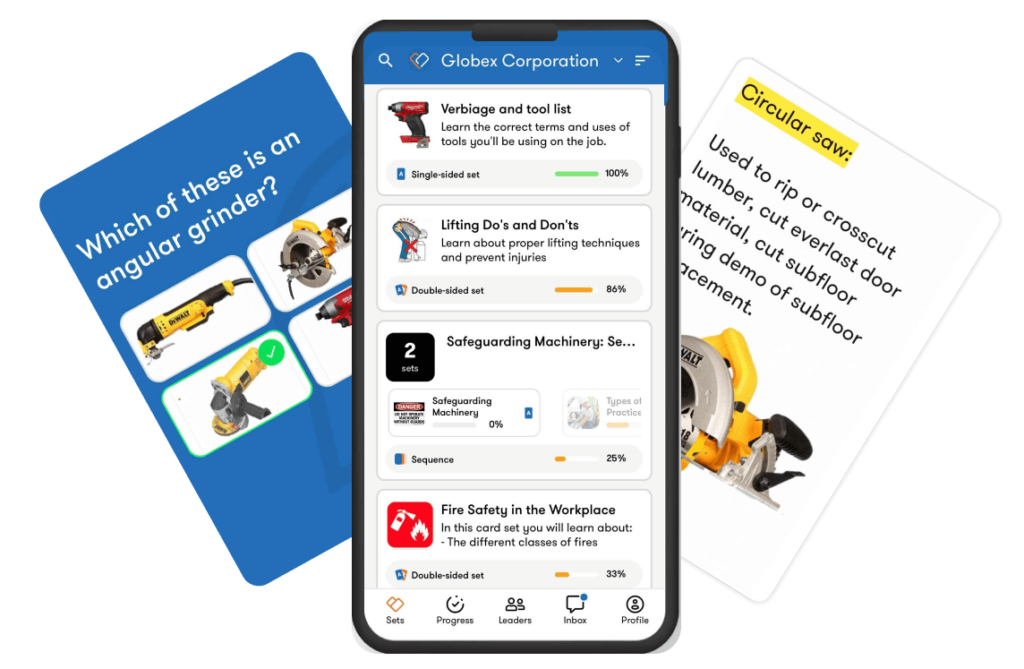After years of school and starting new jobs, we’ve all discovered our preferred methods for learning new information. These methods usually involve rereading notes countless times, crafting detailed flashcards, and highlighting what we think we’ll need to know later.
Unfortunately, none of these are part of the highly effective active recall method.
Cognitive science research shows that traditional ways of studying are not effective. We’re talking about passive learning— simply reading and rereading notes has little success in improving memory retention.
Instead, engaging in active learning significantly increases retention and understanding.
Active recall includes writing your own questions as you read, explaining what you know in your own words, and creating single-answer flashcards. It’s all about engaging your brain through retrieving information.
An exhaustive meta-analysis looked at the efficiency of different study methods, and the findings were clear— passive learning strategies provide minimal benefits. These methods fail to engage our ability to recall information, and test our understanding. Although it’s a long-standing strategy, rereading notes has been singled out as one of the least effective learning methods.
Bottom line: active recall is the most efficient way to learn. Let’s explore how and why this method leads to the most successful learning outcomes.
What is active recall?
Active recall is the process of actively retrieving information from memory, and is proven to be a highly effective study technique. One way to use the active recall method is to create questions based on what you want to learn. You then continuously ask yourself those questions, forcing your brain to actively retrieve the information needed. When simply re-reading notes, you are passively learning, which is less effective.
Here are the main things to know about active recall:
- You are actively testing yourself to remember information, instead of just reading it again. Doing this helps strengthen your memory, and you’ll remember things longer.
- Studies have found that active recall helps improve test scores and recall better than just reading over notes.
- You can use flashcards, practice tests, pictures, and your own practice questions to study this way.
- Combining active recall and spaced repetition will improve your overall learning outcomes.
- Active recall is effective because it makes you work to remember things, which helps improve retention in the long run.
Active recall is a great way to study because it involves remembering information on your own. It’s proven to help you learn better than just reading your notes. Adding active recall to your study routine makes you more likely to absorb important information.
How does active recall differ from other study techniques?
The main difference between active recall and other study techniques is that you’re not just highlighting your notes, and reading them repeatedly. With active recall, you’re actively retrieving information from memory rather than just recognizing it.
Here’s what makes active recall different:
- Active recall means you test yourself and try to remember information without looking at your notes. Passive ways of studying just mean looking at the information again and again.
- Active recall helps you see what you don’t know well, and makes you focus on those parts. Passive studying doesn’t give you that kind of feedback.
- Studies have shown that the active recall method is much better than passive ways for remembering things for long-term learning and in-depth understanding.
- Microlearning approaches like flashcards, taking practice tests, and quizzing yourself are good active recall strategies.
Pulling information out is what makes active recall much better for long-term learning and retention than other study methods.
The cognitive science behind active recall
Active recall is more than a study habit. It’s a powerful cognitive strategy grounded in extensive research. To appreciate its effectiveness, let’s explore two areas of cognitive science: memory consolidation and the role of active retrieval in strengthening neural connections.
Memory consolidation
Memory consolidation is when our brains turn short-term memories into long-term ones. This process is crucial for learning, and allows us to retain information over long periods of time, combating challenges like Ebbinghaus’ forgetting curve.
A study by researchers Karpicke and Roediger demonstrated that students who used active recall performed better on long-term memory tests than those who engaged in passive study techniques.
Active recall engages the brain intensively. When you attempt to recall information without cues, you are testing and reinforcing your memory. Every time you successfully retrieve information, your neural pathways are strengthened. Future recalls become easier and more reliable.
Neurological benefits
On a neurological level, every time you engage in active recall, you reinforce a complex network of associations. Using refresher training to do this increases the likelihood that you will remember the information later. It’s now embedded in a web of related concepts and experiences in your brain. Think of it like strengthening a muscle by lifting weights. The more you lift, the stronger the muscle becomes.
The effort you put into active recall triggers emotional and cognitive reactions that further cement concepts into your memory. The challenge of recalling information, paired with the satisfaction of success reinforces the learning experience. Emotional engagement like this is absent with passive reading.
The cognitive science behind active recall shows why it’s such an effective learning technique. As the secrets of the brain continue to be unlocked, active recall stands out as a way to improve cognitive processes.
What are the benefits of using active recall?
The benefits of using active recall all come down to how you study. It helps you remember things for longer than just reading your notes. Trying to remember and recall things helps improve your brain’s neural pathways.
If you’re just reading and recognizing information, it won’t stick. Using tools like active recall tools you’ve created can help you retain information longer.
When you need to remember important information to do your job, committing it to long-term memory is what counts.
How do you practice active recall?
Practicing active recall can be simple and effective. Here are some of the ways you can get started.
1. Flashcards
- Flashcards are a classic example of active recall. You must first rewrite the information you’re learning, and then retrieve it from memory when using your flashcards.
- Be sure to avoid multiple-choice flashcards. Those just involve recognition rather than recall.
- Try making flashcards with diagrams or images on one side, and labels with explanations on the other to improve retention.
2. Practice questions
- When taking notes, write down questions you can use to test yourself later.
- When you’re ready, try to answer the questions you’ve written without looking at your notes.
3. Teach someone else
- Either pretend or actually teach someone else the material you are learning. Explain it out loud without referring to your notes.
- Work to actively recall and articulate the information accurately.
- You can do this with colleagues or an imaginary audience.
4. Spaced repetition
- Revisit the information and retest yourself at spaced intervals. Don’t cram all of your learning in at once.
- Spaced repetition will help strengthen neural pathways and increase retention.
5. Mobile learning apps
- Use a mobile learning platform that allows you to build your own flashcards an quizzes, and then access them from your phone to study.
- By taking the time to create these resources for yourself or your team, and then making them accessible on your phone, you make it easy and convenient to practice your knowledge whenever you have free time.
Remember, the key to active recall is making an effort to retrieve information from memory. While it can be challenging at first, with practice, it becomes a highly effective way to learn and retain information.
Transform your training with active recall: mobile, personalized, and powerful

Active recall for professional development
Active recall isn’t just for academic study. It’s an equally powerful tool for professional development. Knowledge is constantly evolving, and the ability to learn efficiently is becoming more critical than ever. Active recall can be a game-changer for professionals.
Mastering new skills
The ability to adapt and learn new skills quickly is invaluable. Active recall can help accelerate learning processes.
For example, when learning a new software tool, actively recalling the steps strengthens your understanding and retention of the material. Using this method is more effective than passively reading documents or watching videos because it forces you to engage in your learning.
Certifications
Preparing for certification exams often means learning a vast amount of information. Active recall is particularly beneficial in this situation and can dramatically improve retention.
Job-specific knowledge
Staying up to date with information in your field is essential for professional growth. Active recall can help you retain industry-specific knowledge, such as new regulations, new technology, or best practices. Regularly quizzing your team and engaging in discussions where you need to recall this knowledge ensures they will remain up to date.
The ultimate benefit of using active recall in professional development is establishing a habit of continuous learning. Today’s fast-paced professional environment is constantly changing. Adapting and applying new learning will keep you relevant in an ever-changing world.
FAQs
What is the active recall method?
The active recall definition is a strategy that focuses on activating your memory to recall information. By actively engaging with the material through methods like self-quizzing, flashcards, or reteaching to others, you develop a deeper understanding of the information and retain the information longer.
Actively engaging with the material forces your brain to strengthen its neural connections, making it easier to retrieve it later. Active recall is more efficient and effective when you focus on areas that need improvement.
What does active recall look like?
Active recall can take on different forms, all of which involve pulling information from your brain without needing to reference the original learning material.
Here are a few examples of how to practice active recall:
- Flashcards
- Question generation
- Self-quizzing
- Using a mobile training platform
- Teaching others
What are the steps for active recall?
Create test materials through questions or flashcards. These should challenge you to remember key information. Write short-answer questions and diagrams when appropriate.
Test yourself without looking at your notes. Practice recall by writing down or saying the information out loud. Doing this forces you to retrieve information from memory.
Check your answers to help identify learning gaps.
Use spaced repetition to revisit your test materials. Doing this will strengthen neural connections and improve retention.
Limit passive studying activities like rereading and highlighting. Most of your study time should be dedicated to active recall exercises.
Making an active effort for active recall
Embracing active recall as your go-to study method can dramatically transform your learning outcomes. Actively engaging with the material and challenging yourself to retrieve information from memory aids in deeper understanding and lasting retention.
Effective learning isn’t just about the time you put in. Using active recall strategies maximizes the outcomes of the time you spend learning.
Key takeaways
- Active engagement is crucial to the success of active recall outcomes. Retrieving information from memory significantly boosts learning and retention.
- Regularly testing yourself helps highlight areas of weakness. Doing this allows you to focus your studies more effectively.
- Combining active recall with spaced repetition further strengthens memory and understanding.
- Active recall is a powerful learning tool that builds a foundation for lifelong learning and success.
Drive learning outcomes with active recall in TalentCards, available on-demand for your team



